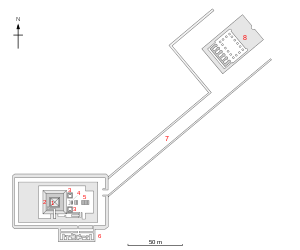Sun Temple of Userkaf
| Sun temple of Userkaf (Arabic: معبد الشمس في أوسركاف) in hieroglyphs | |||||
|---|---|---|---|---|---|
nḫn-Rˁ Nekhen-Ra | |||||
The Sun Temple of Userkaf was an ancient
Excavations
The sun temple of Userkaf was discovered by Karl Richard Lepsius in 1842, then director of the Prussian expedition to Egypt. Lepsius did not recognise the sun temple as such and rather included it in his pioneering list of pyramids, under the number XVII. Lepsius only investigated the monument superficially and the first excavations of the temple took place much later, in 1907 and 1913, under the direction of Ludwig Borchardt. Borchardt's main work however was on the nearby royal cemetery at Abusir. The temple was the focus of a dedicated excavation only 40 years later, between in 1954 to 1957, this time under the impulse of the German-Swiss expedition led by Herbert Ricke.[3] The results were published in two volumes.
Temple layout

The temple was found heavily destroyed so that any reconstruction remains very problematic. The main temple consisted originally of one big solid
The valley temple was found heavily destroyed too. It had most likely an open court with pillars and several chapels at the back. The number of these chapels is unknown.[9] In the debris of the temple was found a stone head of a king, most likely king Userkaf. It is possible that the stone temple was not built under Userkaf, but later perhaps under Niuserre. There were found building marks that are otherwise only attested for this king. Both temples were not decorated with any reliefs or inscriptions, at least nothing of this survived.
Many seal impressions were found. Most of them bear king's names. King Userkaf,
References
- ^ The last hieroglyph shown here is an approximation of the correct one which shows a squat obelisk on a flat base called a ben-ben
- ^ Bard 2015, p. 166.
- ^ Ricke: Sonnenheiligtum, I, 2
- ^ Ricke: Sonnenheiligtum, I, 3-31
- ^ Ricke: Sonnenheiligtum, I, 15
- ^ Ricke: Sonnenheiligtum, I, 18
- ^ Ricke: Sonnenheiligtum, I, 13, fig. 8
- ^ Ricke: Sonnenheiligtum, I, 20-22
- ^ Ricke: Sonnenheiligtum, I, 35-47
- ^ Edel, et al.: Das Sonnenheiligtum des Königs II, 83
- ^ Edel, et al.: Das Sonnenheiligtum des Königs II, 82
- ^ Edel, et al.: Das Sonnenheiligtum des Königs II, 115-118
Bibliography
- Bard, Kathryn (2015). An Introduction to the archaeology of ancient Egypt. John Wiley & Sons, Inc. ISBN 978-0-470-67336-2.
- Herbert Ricke: Das Sonnenheiligtum des Königs Userkaf, Band I, Der Bau (Beiträge zur ägyptschen Bauforschung und Altertumskunde, Heft 7), Kairo 1965
- Elmar Edel, Gerhard Haeny, Wolfgang Helck, Werner Kaiser, Peter Kaplony, Herbert Ricke, Siegried Schott: Das Sonnenheiligtum des Königs Userkaf, II, Die Funde, (Beiträge zur ägyptschen Bauforschung und Altertumskunde, Heft 8), Wiesbaden 1969
